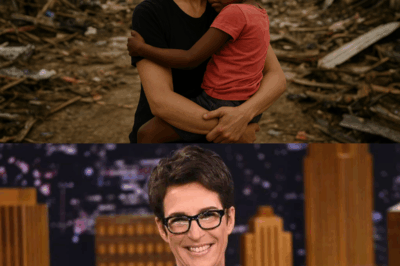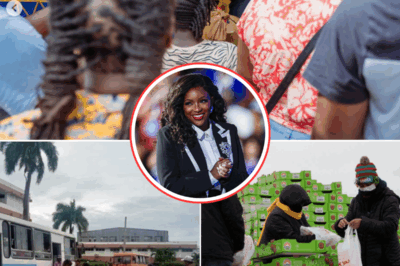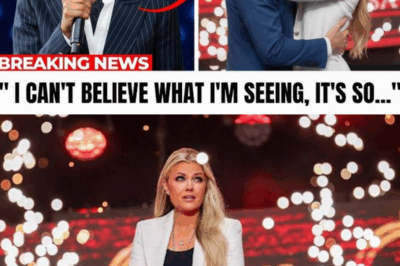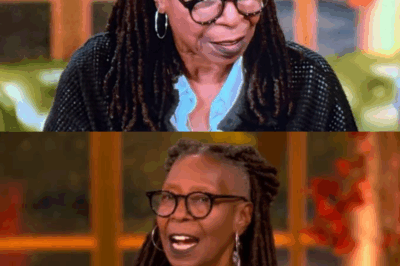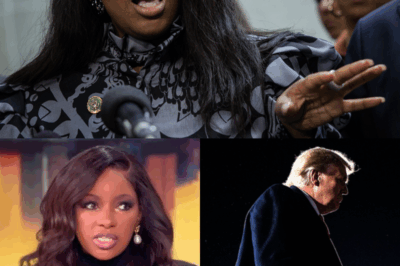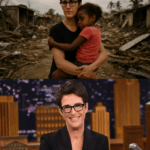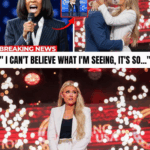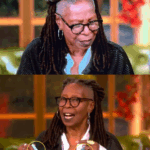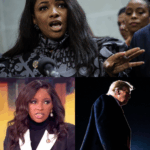Late-night television has always been a space for unexpected moments—where comedy, politics, and pop culture collide in ways that surprise and delight audiences.
But on one unforgettable summer night in July 2025, The Late Show with Stephen Colbert delivered something far beyond the typical late-night formula.
It wasn’t just a viral moment or a clever interview; it was a cultural phenomenon. Stephen Colbert, the sharp-tongued satirist and late-night legend, joined forces with Bad Bunny, the Puerto Rican global superstar whose music and persona have reshaped the entertainment industry.
Together, they created a moment that will go down as one of the most iconic collaborations in late-night history.

The pairing itself seemed improbable. Colbert, the bespectacled intellectual whose humor often leans toward political commentary, is a master of the monologue, a storyteller who thrives on wit and irony.
Bad Bunny, on the other hand, is a reggaeton rebel, a performer who exudes charisma and authenticity through his music, style, and unapologetic embrace of his identity.
On paper, their worlds couldn’t seem further apart. But as the night unfolded, it became clear that this unlikely duo shared something deeper: a passion for connection, creativity, and breaking boundaries.
The timing of their meeting added an extra layer of significance. Just weeks earlier, CBS announced that The Late Show with Stephen Colbert would come to an end in May 2026, marking the conclusion of Colbert’s illustrious late-night career.
While the official reason cited budget adjustments, rumors swirled about creative differences between Colbert and network executives.
The news left fans nostalgic and eager to savor every remaining moment of Colbert’s farewell season. And with Bad Bunny as his guest, Colbert proved he wasn’t going out quietly—he was going out with fireworks.
From the moment Bad Bunny stepped onto the stage, the energy in the room shifted.
Dressed in a playful golfer-inspired outfit—a nod to his upcoming cameo in Happy Gilmore 2—he radiated confidence and charm.
Colbert, ever the quick-witted host, greeted him with mock solemnity, calling him “the most stylish guest to ever enter this building.” Their banter was effortless, blending humor and sincerity in a way that felt both spontaneous and intimate.
But it wasn’t just the conversation that captivated audiences—it was the chemistry between them.
Bad Bunny teased Colbert about his famously conservative style, suggesting he could pull off a mullet, while Colbert groaned theatrically about his hairline.
The audience roared with laughter, but beneath the jokes was a sense of mutual respect and curiosity.
Colbert wasn’t just interviewing a celebrity; he was engaging with an artist whose work has transcended language, genre, and culture.
Then came the moment that sent the internet into a frenzy: Bad Bunny’s impromptu makeover of Colbert.
Declaring, “We make-over you, right now,” Bunny transformed the late-night host into a reggaeton-ready icon.
Out came a mullet wig, a bottle of electric blue nail polish, and a flowing Puerto Rican-print scarf.
Colbert gamely leaned into the transformation, letting Bunny slick his hair and paint his thumbnail.
The makeover culminated in a dance lesson, with Bunny demonstrating the signature hip sway of perreo while Colbert followed suit—surprisingly well for a man in his sixties.
The audience erupted in cheers, and the moment felt raw, unscripted, and undeniably joyous.
Within hours, clips of the segment dominated social media. Fans shared memes of Colbert’s dance moves, while others praised the genuine connection between the two performers.
Even rival late-night hosts chimed in, admitting they hadn’t seen such a fresh and funny moment on TV in years.
The segment wasn’t just entertainment; it was a testament to the power of cultural exchange and the magic that happens when two seemingly different worlds collide.
But the night wasn’t all laughs and dancing. Beneath the humor was a conversation that felt deeply personal and resonant.
Colbert, known for his intellectual approach to interviews, asked Bunny about the duality of his identity—Bad Bunny, the global icon, and Benito, the man behind the music.
Bunny’s response was heartfelt: “Bad Bunny is energy. It’s the stage, the crowd, the music. Benito? That’s the quiet one.
The one who calls his mom every Sunday and eats mofongo with friends.” The vulnerability in his answer struck a chord, reminding viewers that even the biggest stars are human at their core.
The two also discussed Bunny’s recent residency in San Juan, a record-breaking 31-show run that pumped millions into Puerto Rico’s economy.
Bunny explained that the residency wasn’t just about music; it was about reminding his fans—and the world—that Puerto Rico is resilient, a place that rises even in the face of adversity.
Colbert raised an imaginary cocktail in response, toasting to resilience and the power of art to inspire change.
What made the episode so memorable was its balance of humor, heart, and authenticity. Colbert and Bunny weren’t just performing for the cameras; they were connecting as artists and individuals.
Their conversation touched on themes of cultural pride, identity, and the importance of staying true to oneself.
Bunny’s decision to sing exclusively in Spanish, despite his global success, was a powerful statement of cultural pride.
“Why change for applause?” he said. “Spanish is home. Music has no borders.”

Colbert’s admiration for Bunny was evident throughout the episode. As someone who built his career on truth-telling and challenging norms, Colbert seemed genuinely inspired by Bunny’s unapologetic authenticity.
The respect was mutual, with Bunny gifting Colbert a pair of custom sneakers from his Adidas line, emblazoned with the words “Abuelo Perrea” (“Grandpa Dances”).
The playful gesture symbolized the connection they had forged—a reminder that age, language, and background are no barriers to shared joy.
The impact of the episode extended far beyond the Late Show studio. Ratings for the episode surged, particularly among younger viewers, proving that Colbert’s farewell season still had the power to captivate audiences.
Critics hailed the segment as a late-night masterpiece, calling it “a bilingual balm for turbulent times.”
Social media platforms lit up with discussions about the cultural significance of the collaboration, with many praising the way it celebrated diversity and inclusivity.
For Colbert, the episode was a fitting highlight of his final season. As a host who has always blended intellect and humor, he used his platform not just to entertain but to create moments of connection and reflection.
His pairing with Bad Bunny was a reminder of why late-night television matters—it’s a space where conversations can transcend entertainment and touch on the deeper truths of who we are.
As the credits rolled, Colbert turned to the camera with a grin, reflecting on the night’s events.
“Benito says I still can’t dance,” he joked. “But he’s wrong—I just need more practice.”
The audience erupted in applause, and for a moment, late-night television felt alive again—vibrant, bilingual, and unstoppable.
In the end, the collaboration between Stephen Colbert and Bad Bunny wasn’t just a great episode of The Late Show; it was a cultural moment that reminded us of the power of art to bridge divides and bring people together.
It was a celebration of authenticity, creativity, and the joy of being unapologetically yourself.
And as Colbert prepares to say goodbye to late-night television, moments like this will ensure his legacy endures for years to come.
News
💔 “SHE DIDN’T PLAN TO BE A HERO — SHE JUST COULDN’T WALK AWAY.” 🌧️ When Rachel Maddow landed in Jamaica to cover the aftermath of Hurricane Melissa, she expected devastation. What she didn’t expect… was her. A little girl, barefoot in the wreckage, clutching a soaked teddy bear and whispering one word: “Mama.” Reporters looked away. Cameras kept rolling. But Maddow — silent, trembling — stepped forward. That night, she stayed. Days later, she signed the papers that changed both their lives forever. Now, as the world reacts to her unexpected act of love, one haunting question remains: Was this journalism… or destiny?|KF
1. The Storm That Took Everything The storm had no mercy. Hurricane Melissa tore through Jamaica with winds that howled…
😱 “NO CAMERAS. NO PRESS. JUST ACTION.” 💥 When Hurricane Melissa left Jamaica in ruins, everyone expected statements — not silence. But that night, Rep. Jasmine Crockett made a call no one knew about. Hours later, a private shipment — blankets, medicine, and water filters worth $500,000 — quietly left U.S. soil. No press release. No credit. Just a note inside the first box that made rescuers burst into tears. Now, the world wants to know: what did she write?|KF
When Hurricane Melissa finally loosened its grip on Jamaica, what remained was not silence but the faint hum of survival…
💥 “THE TAPES WERE NEVER MEANT TO LEAVE THE BUILDING.” 😳 A Turning Point USA insider has come forward — and what they just leaked about Erika Kirk and the Chief of Staff is sending shockwaves through conservative media. Behind closed doors, secret recordings. Late-night meetings. Deleted emails that someone thought were gone forever. And now, the story is unraveling — faster than anyone can contain it. The insider’s confession doesn’t just expose one scandal… it hints at a network of cover-ups stretching far beyond TPUSA. 👀 Either way, the receipts are coming — and they could change everything. 👉 Full leaked details in the comments (CMT) before they disappear… 🔥👇👇|KF
Late last night, an anonymous insider from Turning Point USA (TPUSA) dropped a bombshell that has sent shockwaves through conservative…
“LIVE MELTDOWN ON NATIONAL TV” — WHOOPI GOLDBERG’S EXPLOSIVE MOMENT LEAVES ‘THE VIEW’ IN CHAOS 😱💥 It started like any other morning at The View. Laughter. Headlines. Controlled chaos. Then — a single note changed everything. As producers slipped Whoopi Goldberg a message mid-segment, cameras caught something no one was supposed to see. With a glare sharper than a knife, she snatched the paper, ripped it to pieces, and tossed it aside — live, unedited, and on national television. The studio froze. Her co-hosts went silent. Viewers at home could feel it — that thick, electric tension pulsing through the screen|KF
Inside Whoopi Goldberg’s Live Meltdown — and the Crisis Shaking Disney’s Daytime Empire It started with a folded piece of…
💥 “NO CAMERAS. NO PRESS. JUST THREE NAMES THE WORLD THOUGHT THEY KNEW.” 🌪️ When the Category-5 monster Hurricane Melissa tore through Jamaica, help was nowhere in sight. Then — without a single announcement — a private jet touched down at dawn. Inside: Rachel Maddow. Stephen Colbert. Joy Reid. No sponsors. No cameras. No entourage. They brought 5 tons of food, medicine, water filters, and $1.5 million in aid, all paid from their own pockets. Locals said they worked through the night — lifting boxes, feeding children, treating wounds — not a single word about fame or press. And when a volunteer asked why they came, Joy Reid quietly answered: “Because the news doesn’t need to cover this — humanity does.” By morning, they were gone. No selfies. No headlines. Just whispers spreading across the island — “Were those really them?” Nobody knows who leaked the flight manifest. But one thing’s certain: this wasn’t charity. This was rebellion — against the silence of comfort. 🕯🌎 👇 Full uncovered story before it disappears…|KF
No cameras. No sponsors. Just three journalists who decided to act, not speak. When Hurricane Melissa struck Jamaica — the…
End of content
No more pages to load


